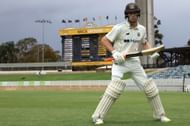Selfless has been the buzzword ever since Steven Smith willed himself to move to the opening position in Test cricket. As the ‘greatest problem solver’ in the world, the former Australian captain wanted to be tied in knots as he supposedly looked for his next challenge.
Eyebrows were raised, as players nearing the end of their careers typically avoid new challenges. But Smith took up the challenge to conquer one of the few things he is still left to – play the red cherry at its freshest with three slips and a gully waiting.
Not that the right-hander hadn’t been in the position to face the new ball. His entry points during his mercurial performance in the 2019 Ashes series were seldom before the new ball became comfortable to negotiate. And yet, Smith aggregated 774 runs in four Tests at well over 100. Having batted numerous times against the new ball even as a No.4, it made sense to face it from the outset.
But ‘to fix what’s not broken’ is the mindset experts were coming from. Then there was the Cameron Green conundrum Australia faced as David Warner’s presence and Mitchell Marsh’s bludgeoning returns had no place for the promising all-rounder in the XI for the Test series against Pakistan. In that light, it was selfless from Smith to go up the order, allowing Green to accommodate at No.4 once Warner bowed out.
Cameron Green repays faith, but Steve Smith on tight rope

The move to promote Green at No.4 proved to be a masterstroke, one which promises to serve Australia for an extended period. Armed with an unbeaten 103 for Western Australia against Tasmania in the Shield clash, Green carried his form to muster 174 against New Zealand in Wellington. The century stand with Josh Hazlewood was the most striking part of his innings as Australia won by 172 runs in the end.
Australia also registered a series win over New Zealand, emerging victorious in Christchurch, thanks to the lower-order batters' never-give-up attitude. But papering over the cracks were Smith’s returns over those four innings against the Kiwis, aggregating 51 runs at 12.75, while the average plummets to 28.50 from 8, contrasting to 67.08 and 61.51 when batting at No.3 and 4, respectively. The only innings of substance on the tour was scoring 31 on Day 1 in Wellington to help Australia soften the new ball.
It’s the nip-backer that has plotted Smith’s downfall two out of four times during the New Zealand tour. It happened once during the home series against the West Indies. It seemed like Smith had turned a corner when he was the last man standing for Australia, 9 runs short of a hundred when Shamar Joseph ran through the Aussie batting line-up to fire the West Indies to a landmark win in Brisbane.
However, the New Zealand tour was a vindication that the time to question Smith’s promotion is now.
Will Australia realize the need for a specialist opener?

Smith has enough credits in the bank to be given an extended run at the top, but he isn’t getting any younger, and neither is Usman Khawaja, the man at the other end. Yet, head coach Andrew McDonald has strongly advocated for him to remain at the top and spoke to the reporters a day after Australia’s thrilling win over New Zealand in Christchurch:
“He’s up for the challenge. I think anytime that Steve Smith fails he sees it as a greater challenge. So, obviously walking away here with 51 runs under his belt in tough conditions, that’ll no doubt drive him for the next challenge. And that next challenge is India, and they await,” McDonald said, as quoted by ESPN Cricinfo.
India is a challenge that the right-hander will cherish, but it could also leave him exposed to all ends up. It’s the five-Test bout that the world awaits, but as far as India look promising, Australia are staring at their batting woes. It’s a batting line-up that hasn’t consistently stood up, needing that one or two performances to turn it around, resulting in six wins out of seven.
The issue is also that Smith’s move to the top has left too many moderately inexperienced players in the middle-order and their inconsistent returns have further dented Australia.
It caught up with the West Indies at the Gabba when Smith’s masterclass wasn’t enough to prevent the storm that Shamar Joseph was. It will be the kind of storm that Australia must expect from India. Jasprit Bumrah’s relentlessness, Mohammed Siraj’s persistence, and Mohammed Shami’s guile can find new ways every innings to tie the hosts in knots.
It could well be enough for India to force yet another away series win over them.
It remains clear that Smith doesn’t care much about retiring with an average of over 60, contrary to most experts’ desire, with the figure now slumping to below 57 presently.
He averaged 42.23 in 2023, with 929 Test runs – proving to be the 2nd highest run-getter of the year – including centuries in the World Test Championship final and the Ashes Test at Lord’s. 42.23 is arguably an enviable average and most batters today would be keen to have it. And yet, it is mediocre by the seasoned Aussie batter’s standards.
But he is not the Smith he once was and Australia desperately need that Bradmanseque version of him for at least the next two summers. Australia don’t play red-ball cricket until the home series against India at the end of the year. Will a County Championship stint help him regain confidence? Is it time for the selectors to recall Cameron Bancroft even if he is not Warner? These are some of the earliest questions Australia must confront soon. But the question is, how soon is too soon?
Brand-new app in a brand-new avatar! Download CricRocket for fast cricket scores, rocket flicks, super notifications and much more! 🚀☄️
